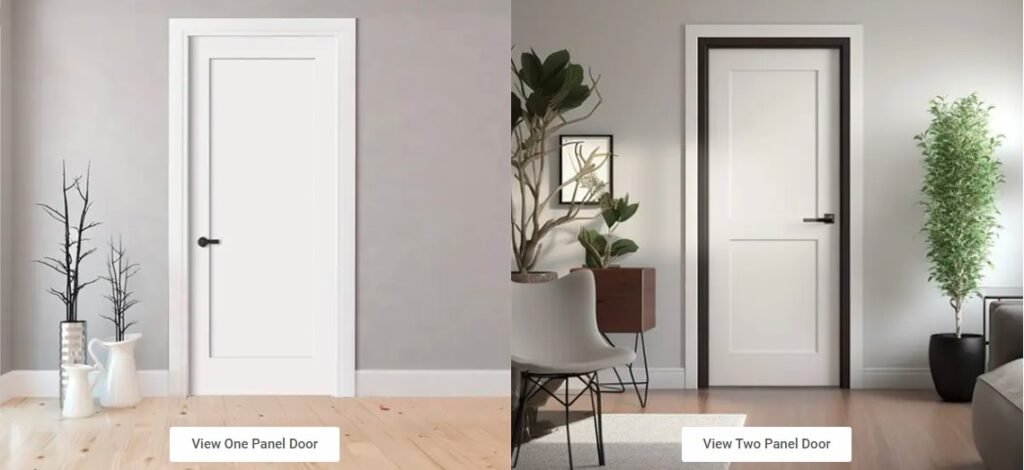Prehung Doors vs. Shaker Doors: A Comprehensive Guide

When it comes to selecting doors for your home, two popular options are prehung doors and Shaker doors. Each has distinct advantages, styles, and installation processes that cater to different needs. Whether you’re renovating, building a new home, or simply upgrading your interior, understanding these door types will help you make an informed decision.
In this blog, we’ll explore:
What Are Prehung Doors?
Advantages and Disadvantages of Prehung Doors
What Are Shaker Doors?
Advantages and Disadvantages of Shaker Doors
Prehung Doors vs. Shaker Doors: Key Differences
Choosing the Right Door for Your Home
Installation Tips for Both Door Types
Let’s dive in!
1. What Are Prehung Doors?
A prehung door is a complete door system that comes fully assembled in a frame, including hinges, jambs, and often a pre-cut strike plate for the latch. Unlike slab doors (which are just the door itself), prehung doors are designed for easier installation since they eliminate the need to mortise hinges or align the door manually.
Types of Prehung Doors:
Interior Prehung Doors – Used for bedrooms, bathrooms, and closets.
Exterior Prehung Doors – Designed for entryways, often with weatherstripping and reinforced security features.
Pocket Prehung Doors – Sliding doors that disappear into the wall.
French Prehung Doors – Double doors with glass panels, often used for patios or dining rooms.
Prehung doors are favored for their convenience, especially in new construction or full renovations where the rough opening is already prepared.
2. Advantages and Disadvantages of Prehung Doors
Pros:
✅ Easier Installation – Since the door is already hung in the frame, installation is faster and requires less skill.
✅ Better Alignment – The hinges and frame are pre-attached, reducing the risk of misalignment.
✅ Weatherproofing (for exterior doors) – Many prehung exterior doors come with built-in weatherstripping.
✅ Wide Variety of Styles – Available in different materials (wood, fiberglass, steel) and designs.
Cons:
❌ Heavier and Bulkier – More difficult to transport and maneuver than slab doors.
❌ Higher Cost – More expensive than buying a door slab separately.
❌ Limited Customization – Modifying the frame or size may require additional work.
3. What Are Shaker Doors?
Shaker doors are a classic, minimalist door style inspired by the Shaker furniture movement, known for its simplicity and functionality. These doors feature a flat panel design with square edges and minimal ornamentation, making them a timeless choice for modern and traditional homes alike.
Characteristics of Shaker Doors:
Flat Panel Design – Clean lines with a recessed center panel.
Square Edges – No elaborate carvings or raised panels.
Versatile Material Options – Commonly made from wood (oak, maple, pine) or MDF for a painted finish.
Suitable for Cabinetry and Interior Doors – Often used in kitchens, wardrobes, and room doors.
Shaker doors are popular in contemporary, farmhouse, and Scandinavian-style interiors due to their understated elegance.
4. Advantages and Disadvantages of Shaker Doors
Pros:
✅ Timeless Design – Never goes out of style, blending well with various décor themes.
✅ Easy to Paint or Stain – Smooth surfaces make refinishing simple.
✅ Durable Construction – Solid wood Shaker doors are long-lasting.
✅ Affordable – Less expensive than ornate panel doors.
Cons:
❌ Limited Ornamentation – May look too plain for some traditional or luxury interiors.
❌ Prone to Dents (if MDF) – Medium-density fiberboard (MDF) versions can chip more easily than solid wood.
5. Prehung Doors vs. Shaker Doors: Key Differences
| Feature | Prehung Doors | Shaker Doors |
|---|---|---|
| Definition | Complete door system (frame + door) | A door style (flat panel design) |
| Installation | Easier, comes pre-assembled | Requires separate hanging (unless prehung) |
| Best For | New construction, full replacements | Modern, minimalist interiors |
| Customization | Limited to frame size | Can be customized in size and finish |
| Cost | More expensive due to full assembly | Affordable, especially in MDF |
| Durability | High (especially exterior prehung) | Depends on material (solid wood > MDF) |
Can a Shaker Door Be Prehung?
Yes! Many manufacturers offer prehung Shaker-style doors, combining the convenience of pre-assembly with the minimalist design.
6. Choosing the Right Door for Your Home
When to Choose a Prehung Door:
You’re installing a door in a new rough opening.
You want a hassle-free installation.
You need an exterior door with weatherproofing.
When to Choose a Shaker Door:
You prefer a clean, modern aesthetic.
You’re refinishing cabinets or interior doors.
You want a cost-effective yet stylish option.
Material Considerations:
Solid Wood – Best for durability and a high-end look.
MDF – Budget-friendly, great for painted finishes.
Fiberglass/Steel (Prehung Exterior) – Ideal for security and insulation.
7. Installation Tips for Both Door Types
Installing a Prehung Door:
Measure the Rough Opening – Ensure it matches the door size.
Check for Level and Plumb – Use shims to adjust the frame.
Secure the Frame – Nail or screw into the studs.
Test the Swing – Ensure smooth operation before finalizing.
Installing a Shaker Slab Door (Non-Prehung):
Mortise Hinges – Cut recesses for hinges on the door and frame.
Align Carefully – Use a level to prevent sagging.
Attach Hardware – Install doorknobs and latches.
For beginners, prehung Shaker doors are the easiest option.
Final Thoughts
Both prehung doors and Shaker doors offer unique benefits depending on your project. Prehung doors save time on installation, while Shaker doors provide a sleek, versatile design. If you want the best of both worlds, a prehung Shaker door is an excellent choice for a seamless, stylish upgrade.
Whether you prioritize convenience, aesthetics, or budget, understanding these door types ensures you pick the perfect option for your home.
Need help selecting doors for your next project? Consult a door specialist or visit a showroom to explore different styles in person!
